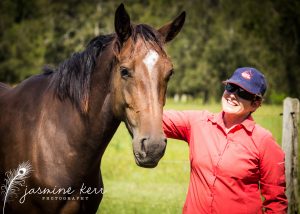“Ten Must Know Tips To Minimise Laminitis Risk In Overweight Horses”

About Larissa
– If you would like to know more about Larissa then listen to her previous chats
First Chat (120) Larissa Bilston
Second Chat (382) – Larissa Bilston 2 – “Ten Points to Help you Feed your Horse Better for Less”
Third Chat (413) – Larissa Bilston 3 – “Ten Things Horse Owners Should Know About Calcium, Oxalates And Their Pastures”
Fourth Chat (444) – Larissa Bilston 4 – “Oils In Horse Nutrition – Ten Tips For Getting The Balance Right”
Fifth Chat (610) – Larissa Bilston 5 – “Ten Valuable Lessons About Feeding Horses For Intense Coat Colour, Shine and Healthy Hooves”
About This Episode
“Ten Must Know Tips To Minimise Laminitis Risk In Overweight Horses”
To Listen to Larissa Bilston 6 on YouTube – Click Here
To Listen to Larissa Bilston 6 on iTunes – Click Here
Or Listen below
“Ten Must Know Tips To Minimise Laminitis Risk In Overweight Horses”
1. If you know your pony is prone to laminitis, diligently monitor fatty deposits, especially the neck crest, on a daily basis.
2. Exercise overweight horses, preferably with ridden or lunge work provided the horse is not lame. Do not exercise post-laminitis until the affected hooves have grown out and a vet has given the all-clear. Additional and regular movement can be encouraged in the yard by utilising hay nets in different places, or use a laneway system so the horse has to travel from food to water.
3. Manage total calorie intake. Limit daily dry matter intake to 1.5 per cent of the horse’s bodyweight either by using a grazing muzzle, laneway system or locking off the pasture and providing low calorie grass hay (ESC + Starch below 10%) in a slow feeder hay nets. Other options are to limit time spent grazing (no more than a few hours in the very early morning) or let horses follow cows/sheep through paddocks – but only if grass is higher than 10 cm.
4. Soak hay for a minimum of half an hour in hot water or one hour in cold water and drain before feeding to reduce calories (but be aware this will also remove some of the vitamins and minerals).
5. DO NOT LEAVE HORSES FOR HOURS ON END WITHOUT FOOD because their bodies will release stress hormones that put the body into ‘drought mode.’ These hormones tell the body to “conserve energy at all costs, because we don’t know when there will be more food to eat” which is counter-productive in a weight loss situation.
6. Avoid high starch/sugar feeds including lush grass and cereal based hard feeds. When this is unavoidable or has happened suddenly, use a hindgut buffer and live yeast probiotics such as Farmalogic Rejuvenate to minimise the impact on the gut microbial population.
7. Horses DO NOT need a ‘laminitis-safe’ hard feed during weight loss. All that is required is roughage, vitamins, omega-3s and a mineral balancer.
8. Horses on a weight loss diet require supplementation with minerals to top up and balance the mineral ratios across the diet as a whole. Equine Vit&Min offers low calorie options for simply balancing the diet – ask us about our EVM Mineral Balancer Pellets, EVM Premium Balancer Pellets or the range of powders to add to a token feed.
9. Feed omega-3s to balance omega-6 levels and therefore reduce inflammation in horses fed a predominantly hay diet. Marine sourced omega-3s have been shown to increase insulin sensitivity. Find out more about Farmalogic Omega Balancer for laminitis prone ponies at www.farmalogicglobal.com.
10. Farmalogic Fat Pony contains natural anti-inflammatories, antioxidants and nutrients to support hoof and joint tissue repair, protect cell membranes from damage by free radical oxidants and improve insulin sensitivity. It is suitable to use before, during and after a laminitic episode. Best results will be obtained when fed as part of a well-balanced, calorie-controlled, forage-based diet containing quality vitamins, minerals and protein.
Time Stamp
01:35 – 1. If you know your pony is prone to laminitis, diligently monitor fatty deposits, especially the neck crest, on a daily basis.
05:55 – 2. Exercise overweight horses, preferably with ridden or lunge work provided the horse is not lame.
05:39 – 3. Manage total calorie intake.
10:33 – 4. Soak hay
11:58 – 5. Do not leave horses for hours on end without food
13:17 – 6. Avoid high starch/sugar feeds including lush grass and cereal based hard feeds.
14:27 – 7. Horses DO NOT need a ‘laminitis-safe’ hard feed during weight loss.
16:38 – 8. Horses on a weight loss diet require supplementation with minerals to top up and balance the mineral ratios across the diet as a whole.
18:43 – 9. Feed omega-3s to balance omega-6 levels and therefore reduce inflammation in horses fed a predominantly hay diet
21:07 – 10. Farmalogic Fat Pony contains natural anti-inflammatories, antioxidants and nutrients to support hoof and joint tissue repair
23:15 – Contact details see below
Larissa’s Contact Details
Phone: 0409 477 404 or +61 409 477 404
Email: larissa@equinevitmin.com or diets@farmalogic.com.au
Website: www.equinevitmin.com
Facebook: www.facebook.com/EquineVitMin
https://www.facebook.com/FarmalogicEquine
Book
Music
BenSound.com
When Larissa is a return guest on Horse Chats, what question would you like to ask her?
(Please leave comment below)